Rehabilitation following ACL reconstruction surgery has evolved significantly over the last 30 years. We have progressed from casting the knee to allowing immediate motion and weightbearing in just a short amount of time. As our understanding of rehabilitation concepts continues to evolve, our focus has shifted towards functional exercise and rehabilitation progressions, which is integral to maximizing results following ACL reconstruction surgery.
We are now seeing professional athletes absolutely dominate their postoperative rehabilitation. Several years ago, Adrian Peterson was the poster boy for returning to sports after ACL surgery, after tearing up the league, and after winning the NFL MVP just months after having ACL reconstruction surgery. While, AP is definitely the exception, not the rule, the postoperative rehabilitation is a huge factor in determining how well people recover from surgery.
Despite these stories of elite-level athletes returning from ACL surgery so quickly, current research tends to lean towards delaying return to sport to maximize outcomes for most people. The rate of return to sport and postoperative failures is simply too high.
While everyone wants to talk about advanced exercises and return to sport, it is probably infinitely more important to ensure that the early phases of rehabilitation go well to avoid complications and allow more advanced drills down the road.
If the early phases of ACL rehab go poorly, you will surely be behind for the duration of your rehab.
The Keys to ACL Rehabilitation
On that note, I wanted to discuss the 6 keys to the early phases of rehabilitation following ACL reconstruction surgery. Master these basics, and the advanced phases get easy.
Diminish Pain and Swelling
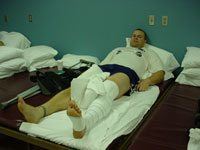
The first key to ACL rehabilitation is simple: diminishing the pain and swelling associated with the surgery. While this is a no-brainer, it is worth reviewing why it is important.
Really, the following list of keys to ACL rehabilitation will all be difficult to achieve without addressing the pain and swelling.
Here are just a handful of important things to consider:
- Numerous studies have shown that pain and swelling essentially shut down the muscles around your knee, specifically your quadriceps. Arthrogenic muscle inhibition has been a large focus of late. Even a small amount of fluid in the joint has been shown to decrease your ability to contract your quads.
- Without a quad, it is hard to function, and you tend to walk around with a bent and stiff knee. This actually fatigues your quadriceps muscle even more, making gains in strength very difficult.
- Pain and swelling will limit your range of motion progression. This, again, may limit your return of strength.
See how pain and swelling is so linked to restoring motion and strength?
It’s an endless cycle.
So, as simple as this concept may be, diminishing pain and swelling should be a primary area of focus initially after surgery.
Compression wraps, ice, intermittent compression machines like Normatec, elevation, ankle pumps, and electrical stimulation. There is always going to be a debate on the internet about ice. But, my biggest advice to patients after surgery is that you can’t ice too much. Neuromodulating pain and attempting to minimize arthrogenic muscle inhibition should be a huge goal of ours.
While all of the above is useful, we also need to educate our patients to not push through too much activity. If swelling is fluctuating, you may be doing too much. Let your swelling dictate your activities.
Restore Full Knee Extension Motion
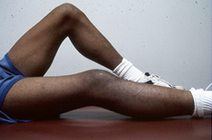
Restoring full knee extension range of motion could be the #1 key to rehabilitation following ACL reconstruction surgery. However, I chose to list it second because addressing pain and swelling has implications for everything discussed in this article.
Really, though, my focus is almost always directed towards restoring full knee extension as soon as possible. One of the more common complications following ACL surgery is loss of motion, with loss of extension being more troublesome than flexion.
When pain and swelling are present, it is just more comfortable to hold your knee in a slightly bent position. Keep it this way too long, and you run the risk of developing scar tissue or arthrofibrosis.
Restoring knee extension immediately after surgery is so important because once it gets tight, it’s often hard to get your motion back. I’d much rather focus on this initially and slowly restore motion than get too tight and then have to aggressively attempt to improve motion. That is never preferred.
Loss of full knee extension does not allow the knee to function properly, even if just a small loss of motion. Plus, studies have shown loss of motion to be one of the most important factors associated with the development of arthritis after ACL surgery.
Luckily, with proper rehabilitation, loss of motion can be avoided.
In addition to my range of motion, soft tissue mobilization, and manual therapy techniques, I always instruct patients to perform a lot of range of motion and stretching exercises at home, essentially once an hour.
I like to show them hamstring stretches and calf towel stretches. I don’t perform these stretches to really enhance hamstring and calf flexibility. I perform them and instruct the patient to also work on knee extension at the same time. So the focus is essentially knee extension.
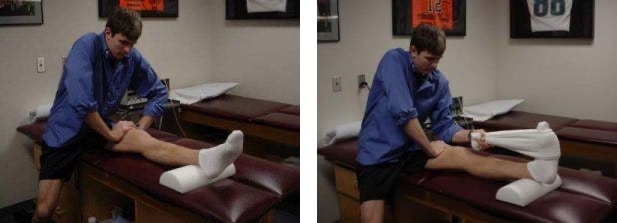
If loss of motion starts to become a problem, I don’t hesitate to introduce low-load long-duration stretching. While some prefer to do this prone with their foot hanging off the table, I find that too aggressive and think supine is the best way to restore knee extension.
My goal is full knee extension by 1 week after surgery. Biomechanical studies have shown that the stress of the ACL graft when stretching into extension is below the forces seen during common functional activities, so there is no need to avoid this motion.
This is such an important concept that you may want to review my past article dedicated to restoring knee extension range of motion.
Gradually Progress Knee Flexion Motion
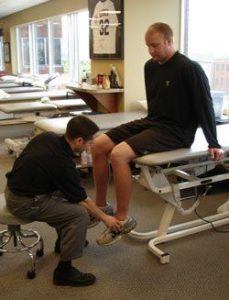
Although the loss of knee flexion doesn’t tend to be as common as knee extension, it does happen and something you don’t want to neglect.
There is often a back-and-forth battle between flexion and extension. The more you work on one, the more you tend to get stiff in the other direction. This is reduced by working on frequent bouts of gentle but progressive range of motion.
I also like to empower the patient to also work on restoring knee flexion, both by stretching as well as through functional motions like mini-squats and eventually lunges. When the patient can control their range of motion progression, their perceived threat is reduced and motion often comes back easier.
Knee flexion is restored more gradually, with about 90 degrees achieved at 1 week and full knee flexion gradually advanced and achieved by week 4-6.
Maintain Patellar Mobility
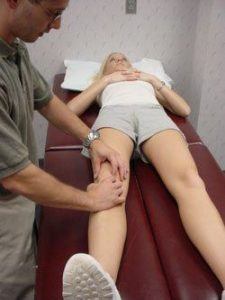
Sometimes one of the reasons that range of motion is reduced is because patellar mobility is lost. If patellar mobility is neglected, the chances of losing range of motion go up significantly.
Full patella mobility is required for knee flexion and extension. As the knee is painful, swollen, and difficult to move, scar tissue can form and limit patella mobility. This is especially true if a patellar tendon or quad tendon graft is used for the ACL reconstruction surgery.
Soft tissue mobilization around the knee and patellar mobilization is performed immediately after surgery. I also like to instruct patients on how to do this themselves and add it to their homework.
Restore Volitional Quad Control

Quadriceps strength after ACL reconstruction is very important to the restoration of function and return to sport.
We want to minimize arthrogenic muscle inhibition as much as possible.
A past study showed a significantly strong correlation between quadriceps strength at 12-weeks follow ACL surgery with ultimate quadriceps strength at the time to return to sport.
This stresses the importance of getting ahead of quadriceps strengthening during the early phases of ACL rehabilitation.
As previously mentioned, there is a reflexive inhibition of muscle control around the knee after surgery due to the pain, inflammation, and swelling. In addition, to address these factors, there are techniques that can be performed to help restore volitional control of the quadriceps muscle.
Lynn Snyder-Mackler, at the University of Delaware, has produced dozens of articles on the use of neuromuscular electrical stimulation (NMES) on the quad follow ACL surgery. Essentially, NMES helps restore quad strength and function faster that just exercises without NMES.
Naturally NMES becomes an important component of the early phases of ACL rehabilitation. I will superimpose most early quad exercises that we perform with NMES. This includes quad sets, straight leg raises, and knee extension exercises.
An added benefit of all these quadriceps contractions is that this also helps restore knee extension range of motion.
Once some volitional control is present, I will often switch from NMES to using biofeedback to enhance volitional control even more. Read more about why to use NMES or biofeedback during rehabilitation.
Restore Independent Ambulation
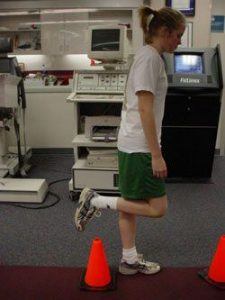
Now that we have addressed the pain and swelling, started to restore motion and patellar mobility, and can now turn on the quads, we put it all together to work on being able to walk without limitations or a limp.
If any of the previously mentioned areas of focus have not been addressed, independent ambulation is often going to be difficult or at least impaired.
I usually have people weight bearing as tolerated around week 1, unless other structures were damaged or need to be protected. We may continue to use the crutches for up to two weeks, however, I still want them to be able to walk and just use the crutches as assistance, rather than, well, a crutch…
I have found weight bearing exercises like weight shifts that focus on transferring your weight and locking out your knee can be helpful initially. I also tend to use cone walking drills to help groove the pattern of shifting weight and transitioning to single leg stance. I have also found backward walking while stepping over a cone to be helpful to rock the body back over the foot and assist with achieving knee extension.
Learn Exactly How We Evaluate and Treat the Knee
Those are my 6 keys to the early phases of rehabilitation following ACL reconstruction surgery. I try to focus on each one of those keys during each session I have with a patient. These 6 keys are so important, that I would rather increase my visits early in the rehab process to assure that these are all addressed, then try to conserve visits (per our insurance limitations).
Really, this is just the tip of the iceberg.
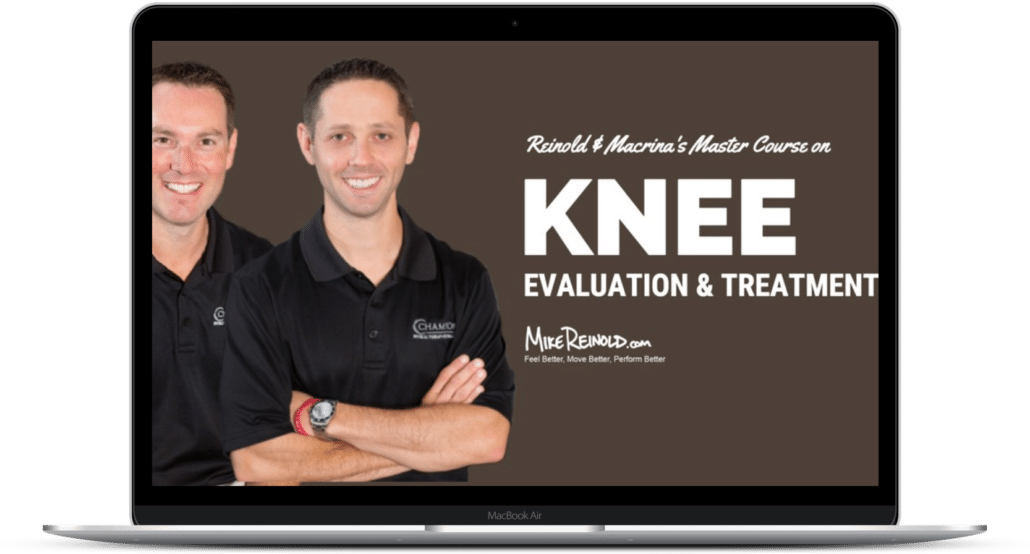
In our online knee course, we discuss the many pathologies of the knee, including ACL reconstruction. We outline a progressive program that starts preoperative and goes until the athlete is ready to return to their sport. If you are interested in learning our full approach, our course has a lot to offer.
You’ll learn exactly how we evaluate and treat the knee and become an expert at knee rehabilitation.






